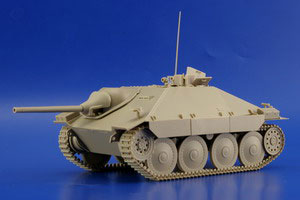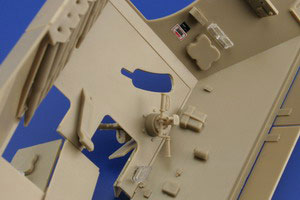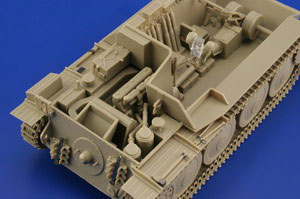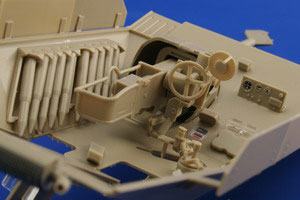| |
Eduard Jagdpanzer 38 Hetzer Early
(3711)
by Frank De Sisto

1/35-scale injection-molded styrene/mulitmedia kit containing 481 styrene
parts (including six clear, 24 for the figures and 71 for the link-and-length
tracks), 114 etched brass parts, paper instrument panel dial faces, one
piece of string, two sheets of wheel masking material, two decal schemes
and a 24-page instruction booklet in dozens of steps. Price: $69.95 USD.
When discussing Eduard’s release of this kit, the first question
most people have asked is, quite simply, “Why?” The DML Jagdpanzer
38 series is considered to be very competently done; they offer early,
late, command and flamethrower versions, and the kits are very reasonably
priced. So why would Eduard issue a new kit? Quite honestly, I have no
answer to that, but I will say this: what they have come up with is different
enough to be appealing, especially if you are a fan of this diminutive
Jagdpanzer, as I am.

First and foremost, Eduard has decided to model the interior of this
vehicle to include the entire fighting compartment and engine compartment.
In fact, the majority of the kits parts are for the interior, while the
first 11 pages in the instruction booklet are devoted to the construction
of this area. Only four pages are devoted to the exterior. Assembly starts
with the various fuel tanks and the engine block, and continues with the
radiator and air filter system, heating air ducts, as well as various
accessories including the small blow-torch used to pre-heat the engine
in extreme cold weather. The main bulkhead houses the Fu5 radio (and its
accessories), as well as the heating vent and is the base for the transmission
drive shaft. Working further forward, there is a fire extinguisher, seats
for the four-man crew, a complete transmission, driver’s controls
(including clear periscopes, foot pedals, steering levers and etched instrument
panel with printed, full-color dial faces), and all sorts of small accessories
and head pads. There are ammunition racks for 19 rounds (ten along the
starboard side superstructure wall and nine along the port side hull wall);
there should provision for 41 rounds.

Eduard has provided a complete Fu8 radio along the port side sponson,
which will allow the modeler to model a “Befhels” (command)
Jagdpanzer. However, there is no “Sternantenna” (star antenna)
or mount. This radio also takes up some of the area where PaK39 rounds
may have been stored (my references are not clear on this point), while
there should be collapsible racks on the floor on the loader’s side
of the gun. These last items are not given in the kit and can certainly
be considered a serious omission. Other small detail omissions are the
lack of a stored MP44 near the driver, no MG34 ammunition stowage; none
of the characteristic flanges that were a feature of German construction
methods are seen, especially around the roof plate.
The main gun comes in two versions, one of which is certainly the PaK39
(Version ‘A”), while the second variation (Version “B”),
appears to depict the StuK40, which was the armament of the post-war versions.
The gun’s sight will move with it, as will the plate on the roof
that covers the opening. The MG34 on its “Rundumsfeuer” (remote
control mount) is quite a little gem as it is completely detailed inside
and out, including control handles and clear part for the sight. The commander
is also provided with a binocular periscope, while all standard periscopes
are made from clear parts. There is a separate roof plate with “Pilze”
(sockets for jib boom) which were not present on early Jagdpanzer 38s
but could be retro-fitted to survivors after July of 1944; depending on
references the modeler may wish to remove these.

The suspension consists of the early style road wheels that had 32 bolts
around the rim, while the drive sprocket is the type without holes on
the rim. There are four choices of idler wheels (four, six and eight holes
on a dished surface), but only the early style, with 12 small holes around
the rim is suitable for this model. However, the rim section is a bit
thicker that it should be and will need to be trimmed. The tracks are
the later style with two ribs in the center of the face of the links,
instead of one. They are very crisply molded in the “link-and-length”
style. The single links all have small ejector pin marks on the inner
faces, while the lengths have two or three pin marks on each section.
Spares are provided to fill the three etched brass racks on the rear of
the vehicle. The bogie spring bundles are nicely detailed but do not account
for the natural nose-heavy attitude of this Jagdpanzer.
The one-piece lower hull has very fine access plate details, while separate
suspension bogie housings, idler wheel mounts, return roller mounts and
final drive mounts are attached to it. The superstructure is a single
piece with a separate roof plate (with separate access hatches) and separate
panels for the engine deck and its access hatches. The detail is delicate
and restrained and there are no knock-out pin marks present on any of
these parts,
either on the inside, or the outside. All handles are separate
as well. The fenders are all separate parts that include nice rib details
on both surfaces; no knock-out pins are present here either. The underside
of the superstructure features, for the first time ever on a Jagdpanzer
38 kit, the etched brass screens that covered the opened area next to
the engine compartment. Well done! The exhaust is the early type with
extended pipe and muffler with perforated cover. This cover, as well as
the mesh for the radiator air intake and the sliding cover, are given
as etched brass parts. Various tools and other fittings are provided including:
multi-part jack (the only part with a visible sink mark on the entire
kit), jack block, shovel, wire cutters, axe, pry-bar (all with separate
etched brass clamps and brackets) and spare rod antenna storage bracket.
A Notek head-lamp and tubular tail lamp are given as is a 2-meter rod
antenna and base, plus a perforated storage box (in etched brass) or the
solid type in styrene. The schürzen plates are styrene and feature
separate hanging brackets. The hull rear plate is separate and is delicately
detailed. It features etched brass tow cable holders (a choice of hooks
or straps) for the provided tow cable, which itself is made from string
and styrene ends.
The four figures provided are rather mediocre and are very reminiscent
of those in the decades-old Italeri kit. The only nice parts of them are
the torsos, which have some crisp details, such as the various medals
and insignia. The remainder of the figures are simply not up to the standards
of even ten years past. There are many details for them on the etched
brass fret including medals, eagles, rank insignia, shoulder straps and
other very useful items, so all is not completely lost.
The instruction booklet in this kit is simply fantastic. It consists
of 24 pages and includes a well-written history of the Jagdpanzer 38 (two
pages) that is enhanced by the use of several archival photographs. There
is a page showing the parts sprues, with certain areas marked as “not
for use”, as well as providing color notes. The next 16 pages deal
with the actual assembly steps. These are presented as full-color CAD
renderings in a multitude of distinct (but un-numbered) steps, with the
parts very clearly shown, and include painting notes. This is followed
by four pages of color notes for the two marking schemes provided for
in the decal sheet. The first is for a vehicle from Pz.Jg.Abt.743, which
was captured by the Polish Home Army during the 1944 Warsaw Uprising,
and christened “Chwat” (translated as brave, or gallant).
The second is for a German-manned vehicle of Pz.Jg.Abt.97, with the Tac
number 112 and the name “Hilde”. Both are accompanied by up
to seven color multi-view profiles which also give alternative colors,
as these were taken from black and white photos. In short, this kit’s
designers took into account the different interpretations of the colors
that can be made from such photos. The decals themselves are cleanly printed
and are in perfect register. There is also a small sheet of decals for
the model’s interior that include warning placards and stencils
as well stowage placement stencils. That is also a rather nice touch.
Finally, as an aid in painting, there are masks for the road wheels and
tires.
Overall, I found the detail of this kit to be good-to-excellent. The
radios as well as the gun mounts are a case in point. I test fitted many
of the larger components and there were no fit problems after normal clean-up
of parts. As I stated earlier, there are no knock-out pin marks visible
on any parts where it counted, and there was only one visible shrink mark
(on the jack). I checked this kit against the drawings in the MBI book
by Francev, Kopecky and Kliment, as well as the drawings in the Panzer
Tracts book by Jentz and Doyle. The kit matches most areas quite well,
but the drawings do not agree in some areas, notably the roof plate. In
that respect, the kit is much closer to the Doyle drawings. The interior
is well done, if certainly incomplete, especially in regards to the ammunition
racks for the PaK39. The etched brass fret is quite complete, although
I would have liked to see this method used for the MG34 shields, and I
suppose some modelers may wonder why the schürzen were also not provided
in this fashion. The retail price of this kit will probably turn off many
modelers, but when one considers that there is a good set of etched brass,
as well as an almost complete interior in the box, this should mitigate
against sticker shock. And, of course, who pays the full retail price
in today’s highly competitive market?
So, if the Jagdpanzer 38 is one of your favorite vehicles, you will simply
have to have this kit. I don’t think you’ll be disappointed.
Highly recommended.
Images provided by Eduard whose products are available at retail and
mail order shops, or direct from the manufacturer at: www.eduard.cz.
|
|